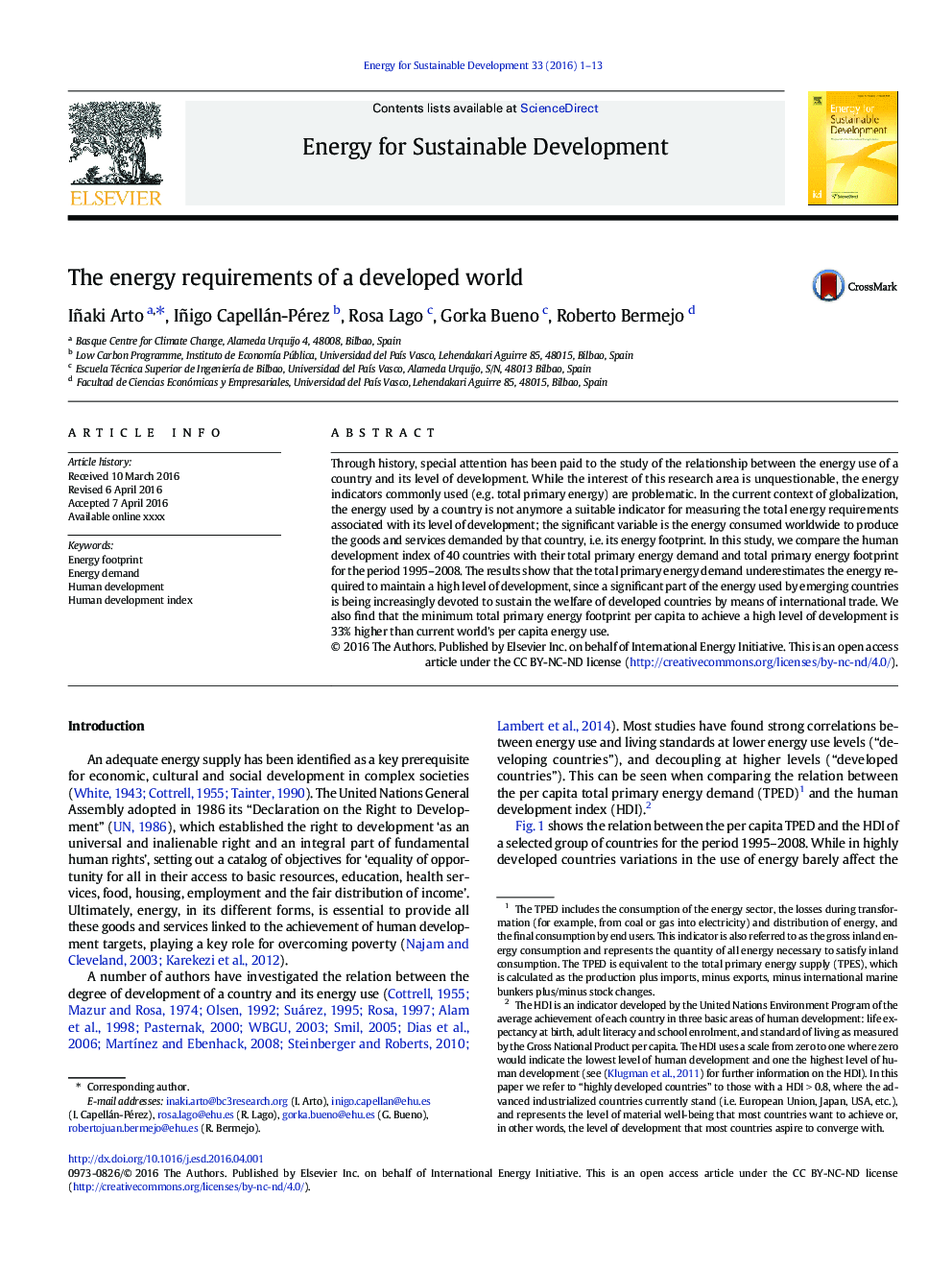| کد مقاله | کد نشریه | سال انتشار | مقاله انگلیسی | نسخه تمام متن |
|---|---|---|---|---|
| 7453768 | 1484397 | 2016 | 13 صفحه PDF | دانلود رایگان |
عنوان انگلیسی مقاله ISI
The energy requirements of a developed world
ترجمه فارسی عنوان
نیازهای انرژی یک دنیای توسعه یافته
دانلود مقاله + سفارش ترجمه
دانلود مقاله ISI انگلیسی
رایگان برای ایرانیان
کلمات کلیدی
پدیده انرژی، تقاضای انرژی، توسعه انسانی، شاخص توسعه انسانی،
ترجمه چکیده
از طریق تاریخ، توجه ویژه ای به مطالعه ارتباط بین استفاده انرژی از یک کشور و سطح توسعه آن داده شده است. در حالی که منافع این منطقه تحقیق غیرقابل انکار است، شاخص های انرژی معمولا استفاده می شود (مثلا کل انرژی اولیه) مشکل ساز است. در زمینه فعلی جهانی شدن، انرژی مورد استفاده یک کشور دیگر شاخص مناسب برای اندازه گیری نیازهای کل انرژی با سطح توسعه آن نیست؛ متغیر مهم انرژی مصرف شده در سراسر جهان برای تولید کالاها و خدمات مورد نیاز آن کشور است، به عنوان مثال، میزان انرژی آن. در این مطالعه، شاخص توسعه انسانی 40 کشور را با تقاضای کل انرژی اولیه و کل انرژی اولیه در دوره 1995-2008 مقایسه می کنیم. نتایج نشان می دهد که کل تقاضای انرژی اولیه، انرژی مورد نیاز برای حفظ سطح بالایی از توسعه را از دست می دهد، زیرا بخش قابل توجهی از انرژی مورد استفاده کشورهای نوظهور به طور فزاینده ای برای حفظ رفاه کشورهای توسعه یافته از طریق تجارت بین المللی اختصاص داده می شود. همچنین ما دریافتیم که حداقل کل میزان اولیه انرژی در سرانه برای دستیابی به سطح بالایی از توسعه، 33٪ بالاتر از مصرف انرژی در سرتاسر جهان است.
موضوعات مرتبط
مهندسی و علوم پایه
مهندسی انرژی
انرژی (عمومی)
چکیده انگلیسی
Through history, special attention has been paid to the study of the relationship between the energy use of a country and its level of development. While the interest of this research area is unquestionable, the energy indicators commonly used (e.g. total primary energy) are problematic. In the current context of globalization, the energy used by a country is not anymore a suitable indicator for measuring the total energy requirements associated with its level of development; the significant variable is the energy consumed worldwide to produce the goods and services demanded by that country, i.e. its energy footprint. In this study, we compare the human development index of 40 countries with their total primary energy demand and total primary energy footprint for the period 1995-2008. The results show that the total primary energy demand underestimates the energy required to maintain a high level of development, since a significant part of the energy used by emerging countries is being increasingly devoted to sustain the welfare of developed countries by means of international trade. We also find that the minimum total primary energy footprint per capita to achieve a high level of development is 33% higher than current world's per capita energy use.
ناشر
Database: Elsevier - ScienceDirect (ساینس دایرکت)
Journal: Energy for Sustainable Development - Volume 33, August 2016, Pages 1-13
Journal: Energy for Sustainable Development - Volume 33, August 2016, Pages 1-13
نویسندگان
Iñaki Arto, Iñigo Capellán-Pérez, Rosa Lago, Gorka Bueno, Roberto Bermejo,
